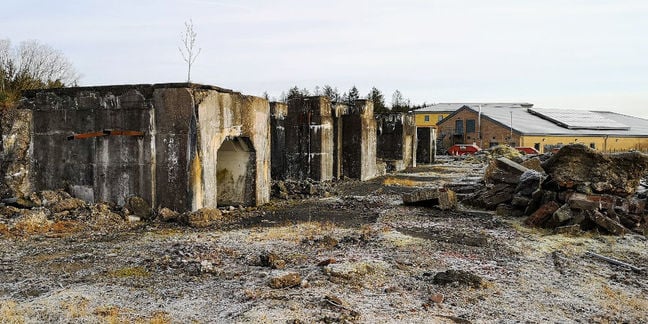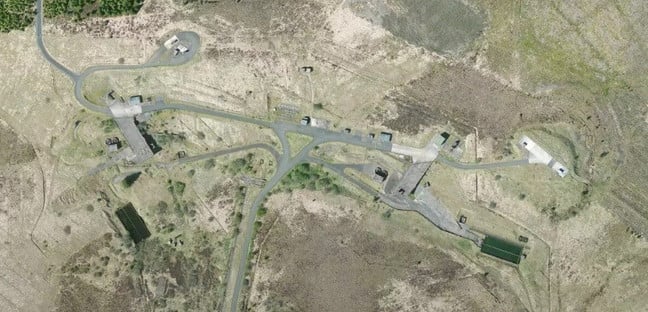This article is more than 1 year old
Talking a Blue Streak: The ambitious, quiet waste of the Spadeadam Rocket Establishment
Memories of missiles on the moors of Cumbria
Geek's Guide to Britain Of all the monuments to Great Britain's efforts to maintain its pre-war status as a global superpower in the post-war world, the remnants of the Blue Streak intermediate-range ballistic missile project are among the most bathetic.
Traces of Blue Streak and related rocket projects can be found in the Australian desert, on an industrial park outside Aylesbury, jutting out of a cliff face on the Isle of Wight and amid the moorlands of Cumbria.
The Reg's expenses budget wouldn't stretch to a visit to the Woomera test site in Australia and while the remains dotted about the Westcott Venture Park industrial estate from what was once the Westcott Rocket Propulsion Establishment (RPE) – and the three test stands on the High Downs near the Needles on the Isle of Wight are certainly worth a visit – they lack the grandeur of what is to be found at Spadeadam in Cumbria.
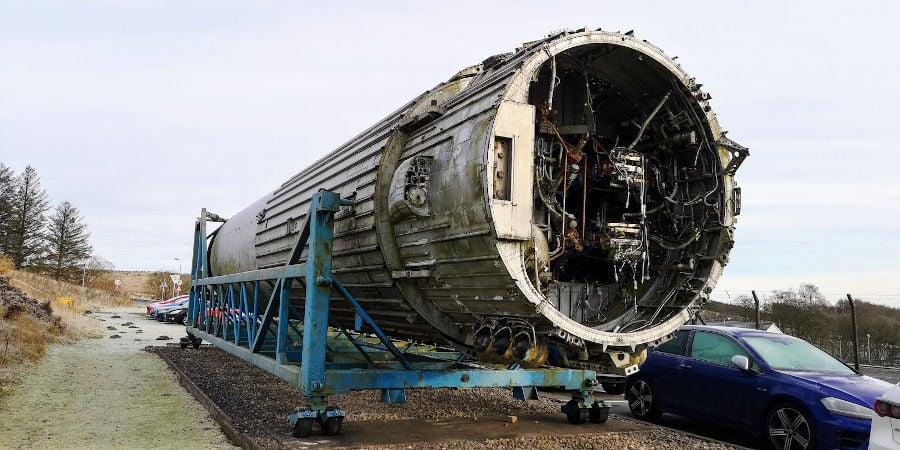
Blue Streak Rocket: the twin rocket motor would usually have been fixed at this end (click to enlarge). All pics: Alun Taylor
For those new to Britain's post-war flirtation with homegrown ballistic missiles, Blue Streak was a 80ft (24m) single-stage rocket powered by twin liquid oxygen (LOX) and kerosene motors developing 137,000lbf (610kN) of thrust.
It was designed to fulfil the British Air Staff's Operational Requirement 1139, of August 1955, for a missile to carry a one-megaton thermonuclear warhead some 2,000 nautical miles (c. 3,700km), though 1,500 nautical miles (2,800km) would suffice to begin with; that would put Moscow within range from the UK.
The missile would be launched from underground silos in the UK and, rather optimistically in retrospect, the Middle East and Cyprus.
The fact that in 1955 Britain didn't possess the basic infrastructure to develop, launch or test a ballistic missile was not regarded as an insurmountable obstacle, given the urgency of the requirement.
By the mid-1950s, rapidly improving Russian air defences were starting to raise serious questions about the long-term effectiveness of Britain's prestigious V-bomber force which was only just entering service with deliveries of the Vickers Valiant starting in February 1955.
And, practicalities aside, if the USA and Russia were developing hydrogen bomb-equipped missiles, then national prestige dictated that Blighty must have them too.
The development of Blue Streak was quickened by an agreement signed in spring 1954 with the US by which the UK was allowed access to Convair's work on the Atlas missile and North American Aviation's Rocketdyne S-3D rocket motors. This prevented the Blue Steak team heading down any blind alleys that the Americans had already discovered and in no way mitigated Blue Streak's "made in Britain" credentials.
This, then, was the background to the foundation of the Spadeadam Rocket Establishment, which was built by the Ministry of Works on behalf of the Ministry of Aviation specifically for the purpose of developing and static-testing Blue Streak.
The facility was managed by the project's principal contractors: De Havilland, which was responsible for the missile's airframe, and Rolls-Royce, which designed the engines.
As of October 1956, the projected costs for building the facilities at Spadeadam were some £12.3m (or around £320m adjusted for inflation). The general opinion is that the final cost was higher but I've been unable to establish an actual figure.
Had the rug not been yanked from beneath Blue Streak in 1960, each of the 64 missiles scheduled to be built for active deployment would have been test-fired at Spadeadam before being shipped to their silos.
The Spadeadam Rocket Establishment (SRE) was situated, to quote a Ministry of Aviation paper from 1961, "on the Cumberland Fells, some 20 miles north-east of Carlisle" and covered an area of approximately 8,000 acres (32.3km2).
The layout
SRE was comprised of five main areas. The three key facilities were the Greymare Hill site for the static testing of completed missiles, the Priorlancy Rigg site for testing rocket motors, and the component parts test area at Rushy Knowe. The remaining two areas were devoted to propellant production by the British Oxygen Company (BOC) and base administration. The site today comprises six separate scheduled monuments, all with very limited access even after you have managed to finagle your way onto the base.
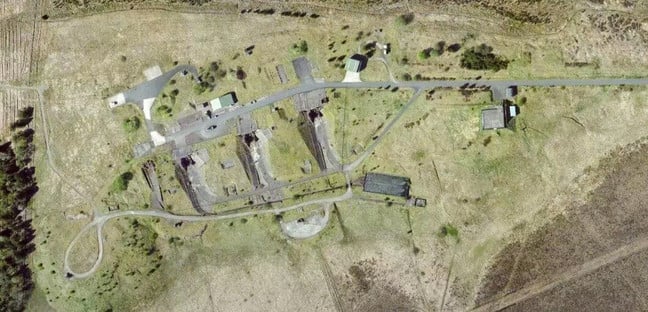
The engine test rigs at Priorlancy Rigg. Note the different design of the unfinished Stand 4 to the left (click to enlarge)
Construction on the site began in 1957 and it closed fully in April 1972 with the termination of the European Launcher Development Organisation, which used Blue Streak as the first stage of its satellite launcher.
Blue Streak as a military project was cancelled in April 1960 with the first completed missile at Los Angeles en route to the test centre at Woomera in Australia. As an important part of Great Britain's nuclear deterrent, Spadeadam had a life of fewer than four years and was left unfinished.
Why the UK's main missile development facility was placed where it was is not hard to fathom. Spadeadam Waste – as it was known – was as close to the middle of nowhere as it was possible to be in the UK while not being on top of a mountain.
An isolated and rather forbidding expanse of heath, woodland and marsh, it is no more inviting today than it was 1,900 years ago, when the Roman army decided to build a fort at Birdoswald, two miles down the road, so they could keep an eye on the recalcitrant locals.
In an unconscious nod to Roman construction methods, the extensive road network that connects the various parts of the Spadeadam test site crisscrosses the boggy and waterlogged ground on brushwood fascines and embankments.
The first clue to what lies hidden at RAF Spadeadam can be found in the base car park. Most RAF bases don't have a ballistic missile – albeit a rather scruffy, mouldy and incomplete one – laying on a transport trailer taking up half a dozen parking bays.
The Spadeadam missile was used to measure the performance and resilience of electrical components. It lacks its Rolls-Royce RZ.2 rocket motor and nose cone, but at over 59ft (18m) in length and weighing some six tons, it is still rather impressive.
The main body of the missile is constructed from stainless steel less than 0.025 of an inch (0.635mm) thick. Only internal pressurisation prevented Blue Streak missiles from collapsing like a wet paper bag.
To get a sense of the scale of the Spadeadam facility you need only note the distance between the current RAF base buildings and the Greymare Hill site; just over 2.5 miles (4km) as the crow flies.
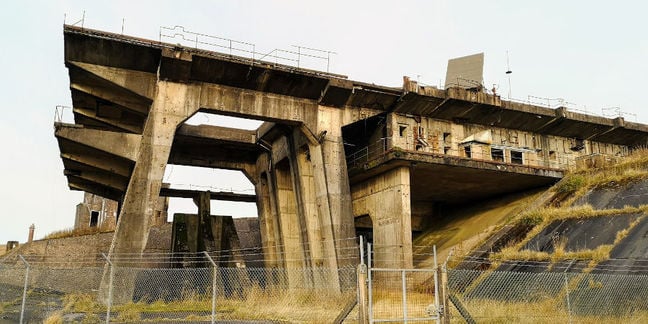
The eastern – completed – missile test stand at Greymare Hill. Note the three sloping concrete supports for the steel thrust deflector (click to enlarge)
The two massive static firing stands (referred to as the west and east stand, for obvious reasons) on Greymare Hill were large enough to accommodate a full Blue Streak missile. Even without their steel superstructures, long since sold for scrap, they dominate the landscape.
The stands, by far the largest structures at Spadeadam, were deliberately sited to exploit the contours of the hill and are set into a natural scarp.
Each test stand consists of a causeway (a huge, hollow, rectangular concrete girder) with instrument rooms below and at the end, and a free-standing thrust pad on which the rocket was tethered.
The rocket and supporting gantry would have moved on rails that ran the length of the causeway. Their positions are marked by two channels and at either end are concrete buffer stops. A circular rail was set into the surface of the thrust pad on which the launcher was set allowing it to be accurately rotated prior to firing.
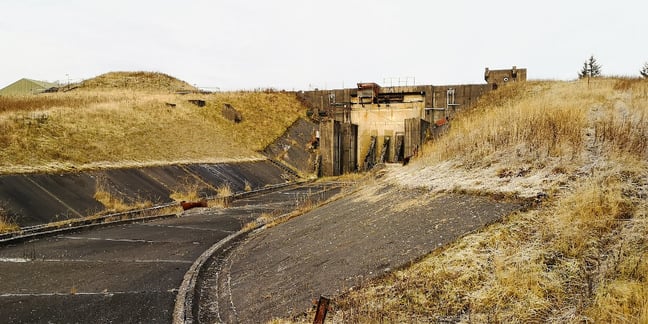
Spillway running from eastern test stand at Priorlancy. This is as close as one gets to the stands. Note the four concrete posts on which the engine test frame would have rested (click to enlarge)
Below each stand was a large concrete spillway leading to an effluent collection lagoon. The spillway beneath the western stand was unfinished at the time of cancellation though its basic outline can be seen outlined by earthworks. Similarly, the sluice gates were never fitted to the western lagoon.
The western stand also lacks the rails that carried the missile to the thrust pad and allowed it to be rotated prior to firing. Either they have been removed or were never installed.
Test firings were controlled from a command bunker some 820 feet (250m) to the south of the stands and connected to them by surface cabling ducts. All the entrances to the Y-shaped control room have been bricked up so access is not possible.
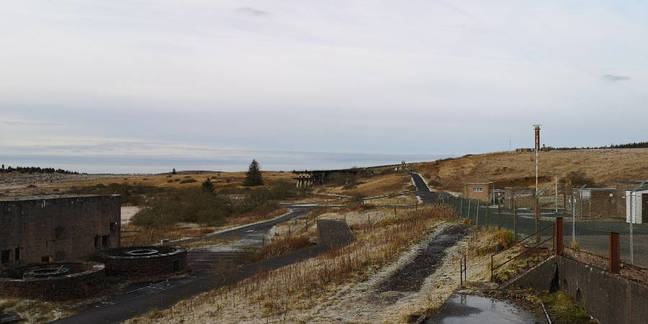
The western test stand as seen from the eastern at Greymare. Note the distance and the LOX storage tank bases at left and the public address tower to the right (click to enlarge)
Judging by the size of the earthwork mounds that protect this and the other control rooms at Spadeadam and the thickness of the reinforced concrete from which they are built some sort of catastrophic explosion was clearly anticipated. Surprisingly every test firing at Spadeadam seems to have gone off without a hitch, a testament to the quality of the underlying engineering of both missile and test facility.
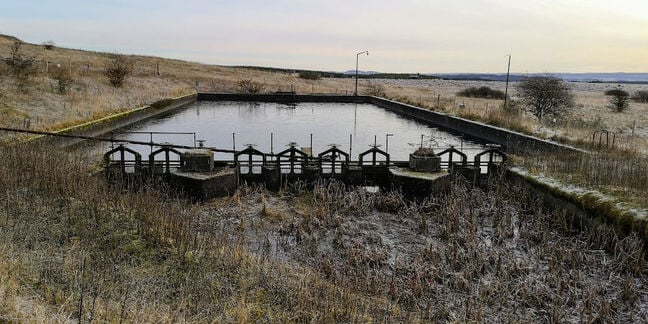
Effluent collection tank at Priorlancy Rigg. This collected coolant and unburnt fuel from test firings (click to enlarge)
The rocket motor test area is situated at Priorlancy Rigg, a little over 2 miles (3.2km) southeast of Greymare Hill and consists of four concrete stands onto which the engines could be mounted for test firing. The basic layout of the first three was based on a Rocketdyne design used at the Santa Susana Field test facility in California.
The four stands were built into a low ridge and below them are the remains of the drainage system built to carry away the huge quantities of waste cooling water and unspent fuel generated by each test firing. Contemporary pictures show steel superstructures over each test stand.
The three eastern-most stands consist of a 38ft (11.7m) concrete back wall from which two concrete protuberances project on which are set four columns that supported the feet of the now long-gone steel towers. Projecting at right angles from the base of the rear wall are three sloping concrete walls that supported a steel efflux bucket.
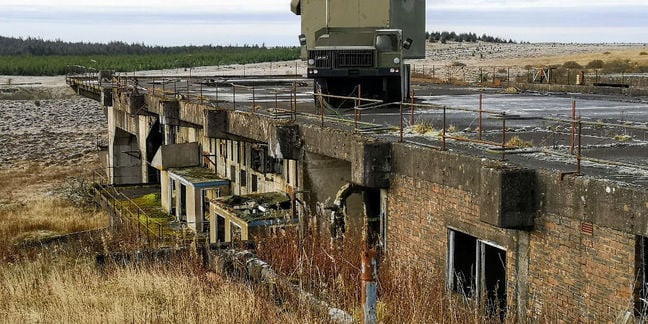
The deck of the eastern test stand at Greymare Hill. Note the instrument rooms below. The vehicle on the deck is a wooden dummy (click to enlarge)
During firing, it was vital for the efflux bucket to be constantly cooled to prevent it from melting. A huge quantity of water was pumped through the rig from two large circular reservoirs to the east of the stands and into a concrete spillway through two large-bore pipes. A drain at the bottom of the four spillways flows into a 200,000-gallon (910,000 litres) reservoir.
The fourth stand was built using a different construction method utilising pre-stressed concrete. There is some debate as to whether or not it had been completed when Blue Streak was cancelled. Judging by the state of it I'd say not.
Stand No. 4 is interesting for another reason. A stainless steel plate bearing the engine mountings was stuck with epoxy resin to a pre-stressed concrete beam. This is generally regarded as the earliest use of epoxy to bond steel and concrete together.
The control room on the eastern side of the site is some 700ft (213m) from the nearest test stand. Tests were monitored through five large periscopes mounted on the western side of the control bunker and four smaller ones set into the roof. The control bunker was linked to the test stands by a 9ft (2.9m) square tunnel, the eastern end of which is visible as an earthwork.
Situated just over one and a quarter miles (2km) to the southeast of Priorlancy Rigg and three-quarters of a mile (1.2km) north of the main administration centre, the Rushy Knowe Component Test Area was used to test and calibrate missile sub-assemblies. In the various test cells, individual parts were placed under extreme conditions to guarantee their reliable performance.
Attached to the southern side of the main test building is the gas turbine house, which originally housed a pair of Avon RA.7 turbojets to provide power to the test cells.
Though the surviving buildings have long since been shorn of their steel superstructures, the solidity of the walls and the thickness of the armoured glass through which the various test cells could be monitored speaks volumes about the potentially dangerous nature of the tests conducted here.
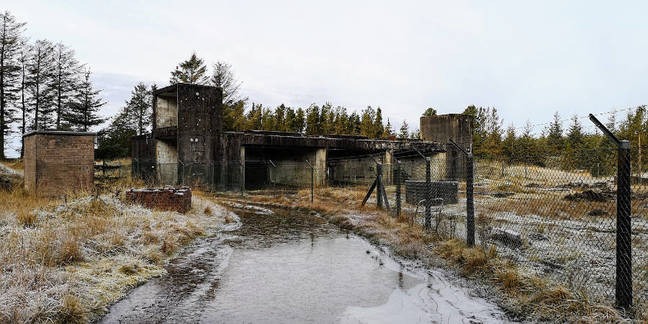
The turbo-pump test cells at Rushy Knowe. Note the fence, barbed wire and flooded, frozen access road. Not visitor-friendly (click to enlarge)
For example, the concrete gaseous nitrogen test facility has walls nearly half a meter thick and many of the test cell floors have a distinct slope to them to facilitate the rapid draining away of spilt fuel. Interestingly according to the scheduling report, some of the original control equipment survives within the main test monitoring building.
It is estimated that when the test site was running at full capacity, it could require up to 250 tons of liquid oxygen and liquid and gaseous nitrogen for every day of testing. Given the remoteness of the site and the problems involved with transporting LOX – not just the hazard but the low boiling point of -183°C which could involve loss due to evaporation – the decision to manufacture on-site was not surprising.
The BOC facility was capable of producing 100 tons of liquid oxygen per day in addition to liquid and gaseous nitrogen. The liquid oxygen was transported by road tankers to the storage tanks in the test areas, while the nitrogen was pumped by pipeline to high-pressure reservoirs in each of the test areas.
Not much remains of the BOC site today, just the concrete supports of the upper floors and the foundations of various storage tanks. The area has become something of a dumping ground for rubble from the rest of the facility and is in a state of ruination so it's hard to get an impression of what it must have looked like when operational.
The most intriguing and mysterious part of the Spadeadam complex is also the least assuming, being little more than a large, curiously circular, pond. What this actually is though is the remains of the prototype for the first-ever hot-launch missile silo.
Long forgotten, the site – designated U1 – was only rediscovered in 2004 when the trees that had overgrown the area were cleared as part of routine forestry management.
Located at the bottom of the Cheese Burn valley at a site with the fantastic name of Whipper Slack some 1,970ft (600m) south of Greymare Hill, a 104ft (32m) diameter overgrown pool is all that remains of a design that is credited with being the direct inspiration for the Titan II missile silos that were in use until 1987.
David Stumpf in his book Titan II: A History of a Cold War Missile Program, categorically states that "Blue Streak was the free world's first in-silo launch weapon system concept".
Initial work on the Blue Streak launch silo was carried out at the Rocket Propulsion Establishment at Westcott where several ⅙ scale models were built and tested. The silo at Spadeadam was intended to be a full-scale prototype but don't imagine there is an entire secret facility buried under the Cumbrian bog.
Even had the Spadeadam development silo been completed only about one-fifth of it would have been underground – having most of the “silo” above the surface made it much easier to analyse the results of test firing and make any resultant modifications.

Access doors to the Greymare site control bunker, now blocked up. Note the earthworks (click to enlarge)
The top of the silo would have been on a level with the side of the valley on which stood the Greymare site. A gantry from the latter would apparently have been constructed to allow for the loading of missiles into the test silo. Looking at the distances involved I'm not wholly convinced this was the intention.
If the work at U1 had come to fruition, 64 Blue Streak silos would have excavated across the UK, the majority at existing RAF bases. Each silo would have protected its missile from a one-megaton ground blast at a half-mile distance and from the resultant electromagnetic pulse. This last was facilitated by lining the silo with ¾ inch steel liner – in effect turning it into a huge Faraday cage.
At the time of cancellation, the design of the silo lid was nowhere near being finalised. One rather interesting part of the agreed specification was it would need to weigh more than 600 tons and open in 17 seconds.
NSFT (Not safe for tourists)
Sadly the vast majority of the remains of the Blue Streak facilities at Spadeadam are bricked up and locked away behind chain-link fencing and barbed wire. Off-limits to any and all visitors. The unmetalled road to the U1 silo is considered unsafe for civilian traffic, so you can't even get near to it.
To be honest, were it not for Google Maps' aerial photographs and Historic England's scheduled monument site reports, I would not have been able to write much of this feature. That's an absolute tragedy in my opinion.
The RAF cannot be blamed for the ruinous and neglected state of the remains, or the extremely limited access. Its obligations under the laws protecting scheduled buildings don't extend much beyond not bulldozing any of the sites to make a carpark or using them for live-fire practice, although parts of the BOC site look like they have suffered explosive damage.
I would argue that given the extent and importance of the site, the time has come to restrict the RAF's activities to one part of the vast area it currently occupies, and hand over at least the more significant scheduled monuments to an organisation less indifferent to their fate, such as English Heritage or The National Trust.
Isolating the Greymare Hill and Priorlancy Rigg sites from the rest of the RAF base certainly seems possible, as would arranging public access from further up the B6138. It would be a more historically apt home for a "National Space Centre" than the current location in Leicester.
One should also bear in mind that the site is littered with ruinous or partly finished concrete structures the function and history of which are obscure. One article I stumbled across makes reference to a small test site at Berry Hill (an area now occupied by the private company DNV GL) and a "Site H" just over a mile east-southeast of Greymare Hill. I could find no corroboration for either being part of the original Blue Streak rocket project.
The shroud of secrecy under which the facility was built and the passing of the men and women who planned, built and operated it as the years tick by increasingly mitigates against a full understanding of the site.
Military missteps
Standing amid the silent, monumental remnants of the Blue Streak project, one is forced to ask "what went wrong?" Why does Spadeadam today not echo to the same sounds as the White Sands Missile Range in New Mexico?
It wasn't simply a matter of money. The cost of deploying Blue Streak was estimated at around £620m, which would equate to about £14bn today. Polaris cost the equivalent of £8bn, Trident £18bn. The cost of replacing the current Vanguard/Trident fleet with four Dreadnought submarines is projected to cost some £40bn just in the short term.*
The argument can actually be made that the UK could more comfortably have afforded a truly independent nuclear deterrent without hollowing-out its conventional armed forces had it opted for Blue Streak in the early 1960s rather than a bought-in SSBN option which had few commercial spin-off benefits.
Indifference to Blue Streak within the RAF played a part. Senior officers throughout the era of Blue Streak would clearly have preferred either the Avro 730 or Skybolt-equipped V-bombers or TSR-2 to a land-based ballistic missile. Ironically it ended up with none of them. Blue Streak was also regarded as a project close to the heart of Duncan Sandys (minister of Defence, 1957-59; minister of Aviation, 1959-60) and the RAF held little love for the man who predicted the end of manned warplanes.
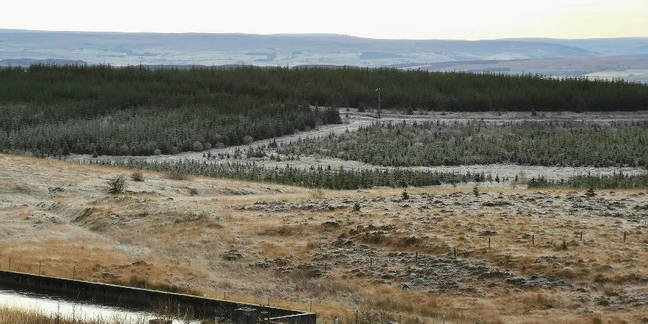
View from Greymare Hill over Cheese Burn and Whipper Slack, site of the U1 prototype hot-launch silo (click to enlarge)
Much was made of the extent to which the Blue Streak silos would make the mainland UK a target for a massive Russian preemptive strike though the exact same arguments could be made for the V-bomber force's main and dispersal bases. Once targeted, the hardened Blue Steel silos would surely have proved more likely to survive than even the Quick Reaction Alert V-bombers. And that is the essence of a deterrent.
Could have been precursor to flourishing British space industry
It's also wrong to argue that Blue Streak was outdated before it even flew. Yes, solid-fuel rockets had advantages, but the Titan II rocket was liquid-fuelled and it helped to hold the line in the Cold War for over 20 years. The test and development site at Spadeadam and the silos themselves would have had a useful lifespan far beyond that of the Blue Streak missile.
Had Blue Streak been seen through to operational service, and had a little more forethought and support been given to its potential applications to civilian use, Great Britain would perhaps have spent less on its nuclear deterrent and could have developed a significant space industry.
A memo, dated October 27th 1961, from the Controller of Guided Weapons & Electronics, Sir Steuart Mitchell to the Minister of Aviation, Peter Thorneycroft regarding the potential use of Spadeadam for space launches noted that "launches from Spadeadam certainly would be feasible, and in nearly every way technically would be better than anywhere else."
The memo, however, ends by saying the minimal risk of damage from overflight accidents makes it politically unacceptable. Britain's domestic space industry, like its ICBM project, was killed by political pusillanimity rather than technical or financial reasons. Standing in the eerily silent and decaying Spadeadam facilities, it all seems a tragically missed opportunity.
Perhaps the project was simply beyond the collective will of a nation still weary from six years of war and becoming increasingly aware of its diminished position in the world and straitened circumstances.
The whole affair was best summed up by a friend of my father who worked at RPE Westcott in the mid-1950s: "Asking why Blue Streak didn't come to fruition is like asking how your dog drove your car into a lamppost. It's the wrong question. You should ask how on Earth it even managed to open the door and start the engine."
RAF Spadeadam
GPS
GPS 55.025013, -2.603407
Post Code
RAF Spadeadam, Gilsland, Brampton, Cumbria, CA8 7AT
Getting there
Today Spadeadam is a functional Royal Air Force base specializing in Electronic Warfare Training for UK and NATO forces. As such it is off-limits to civilian visitors. Special arrangements can be made for group visits by historical societies, academic establishments and the like. All visits are escorted. You are advised to contact the base for details.Public Transport: The nearest train station is Haltwhistle from which you can catch a bus to Birdoswald Roman fort. That's still a 90-minute walk to RAF Spadeadam though.
By car: From Carlisle or Newcastle take the A69 then the B630/B6318 to Gilsland then follow the signs to Butterburn and Spadeadam. The road to RAF Spadeadam is unnumbered and terminates at the base guardhouse.
Recommended further reading
Blue Streak: Britain's Medium Range Ballistic Missile by John Boyes (ISBN 978-1781557006).
A Vertical Empire: A History of the British Rocketry Programme by C.N. Hill (ISBN 978-1848167964)
You can grab a copy of our our refreshing guide to computing and engineering must-sees in Britain in paperback or ebook form, here, or read more about them here. ®
*According to government figures and adjusted for inflation using the Bank of England historic inflation calculator.
